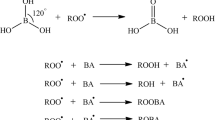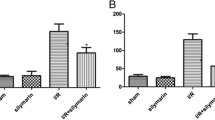Abstract
Renal ischemia and reperfusion injury is the major cause of acute renal failure and may also be involved in the development and progression of some forms of chronic kidney disease. The aim of this study was to evaluate whether doxycycline, a member of the tetracycline family of antibiotics, protects kidney tissue or not. 36 Sprague-Dawley rats (200–250 g) were used. The animals were divided into three groups: control, ischemia/reperfusion and ischemia/reperfusion+doxycycline group. Rats were subjected to renal ischemia by clamping the left pedicle for 1 h, and then reperfused for 1 h. The ischemia/reperfusion+doxycycline group were pretreated intraperitoneally with doxycycline suspension (10 mg/kg) 2 h before the induction of ischemia. Our results indicate that malondialdehyde, matrix-metalloproteinase-2, interleukin-2, interleukin-6, interleukin-10, interleukin 1-beta and tumor necrosis factor-alpha levels were significantly higher in the ischemia/reperfusion group than those in the control group. Doxycycline administration significantly decreased these parameters. Tissue inhibitor of metalloproteinases-1 levels also increased after ischemia/reperfusion and decreased with doxycycline pretreatment, but these changes were not significantly different. Glutathione levels significantly decreased after ischemia/reperfusion injury when compared with the control group and doxycycline pretreatment significantly increased glutathione levels when compared with the ischemia/reperfusion group. Apoptotic cells and p53 positive cells were significantly decreased in doxycycline treated group. These results suggest that doxycycline reduces renal oxidative injury and facilitates repair. Doxycycline may play a role in a renoprotective therapeutic regimen.
Similar content being viewed by others
References
Arıkan, Y., Tosun, M., Saykol, V.,et al. (2008): P53 expression and apoptosis in liver and spleen during CO2 pneumoperitoneum.Langenbecks Arch Surg,393, 877–882.
Avlan, D., Tamer, L., Ayaz, L.,et al. (2006): Effects of trapidil on renal ischemia-reperfusion injury.J Pediatr Surg,41, 1686–1693.
Bálint, É., Vousden, KH. (2001): Activation and activities of the p53 tumor suppressor protein.Br J Cancer,85, 1813–1823.
Chander, V., Chopra, K. (2005): Renal protective effect of molsidomine and L-Arginine in ischemia-reperfusion induced injury in rats.J Surg Res,128, 132–139.
Clark, WM., Lessov, N., Lauten, JD.,et al. (1997): Doxycycline treatment reduces ischemic brain damage in transient middle cerebral artery occlusion in the rat.J Mol Neurosci,9, 103–108.
Daemen, MA., Van De Ven, MW., Heineman, E.,et al. (1999): Involvement of endogenous interleukin-10 and tumor necrosis factor-α?in renal ischemia-reperfusion injury.Transplantation,67, 792–800.
Erkasap, S., Erkasap, N., Koken, T.,et al. (2004): Effect of leptin on renal ischemia-reperfusion damage in rats.J Physiol Biochem,60, 79–84.
Golub, LM., Lee, HM., Ryan, ME.,et al. (1998): Tetracyclines inhibit connective tissue breakdown by multiple non-antimicrobial mechanisms.Adv Dent Res,12, 12–26.
Griffin, MO., Jinno, M., Miles, LA.,et al. (2005): Reduction of myocardial infarct size by doxycycline: a role for plasmin inhibition.Mol Cell Biochem,270, 1–11.
Kacmaz, A., Polat, A., User, Y.,et al. (2003): Octreotide: a new approach to the management of acute abdominal hypertension.Peptides,24, 1381–1386.
Kienle, K., Rentsch, M., Müler, T.,et al. (2005): Expression of BCL-2 in liver grafts after adenoviral transfer improves survival following prolonged ischemia and reperfusion in rat liver transplantation.Transplantation Proc,37, 439–441.
Krakauer, T., Buckley, M. (2003): Doxycycline is anti-inflammatory and inhibits staphylococcal exotoxin-induced cytokines and chemokines.Antimicrob Agents Chemother,47, 3630–3633.
Liu, P., Xu, B., Spokas, E.,et al. (2000): Role of endogenous nitric oxide in TNF-α?and IL-1β generation in hepatic ischemia-reperfusion.Shock,13, 217–223.
Mannello, F., Gazzanelli, G. (2001): Tissue inhibitors of metalloproteinases and programmed cell death: conundrums, controversies and potential implications.Apoptosis,6, 479–482.
Mattson, DL., Wu, F. (2000): Nitric oxide synthase activity and isoforms in rat renal vasculature.Hypertension,35, 337–341.
Mejia-Vilet, JM., Ramirez, V., Cruz, C.,et al. (2007): Renal ischemia/reperfusion injury is prevented by the mineralocorticoid receptor blocker spironolactone.Am J Physiol Renal Physiol,293, F78–86.
Ozben, T. (2007): Oxidative stres and apoptosis: Impact on cancer therapy.J Pharm Sci,96, 2181–2196.
Pitcher, J., Bradway, D., Meldrum, KK.,et al. (2004): Trasylol (aprotinin) decreases kidney interleukin 1-beta and IL-6 levels following renal ischemia and reperfusion injury.J Surg Res,121, 275.
Roach, DM., Fitridge, RA., Laws, PE.,et al. (2002): Up-regulation of MMP-2 and MMP-9 leads to degradation of type IV collagen during skeletal muscle reperfusion injury; protection by the MMP inhibitor, doxycycline.Eur J Vasc Endovasc Surg,23, 260–269.
Roczniak, A., Levine, DZ., Burns, KD. (2000): Localization of protein inhibitor of neuronal nitric oxide synthase in rat kidney.Am J Physiol,278, F702-F707.
Sener, G., Sehirli, O., Velioglu-Ogunc, A.,et al. (2006): Montelukast protects against renal ischemia reperfusion injury in rats.Pharm Res,54, 65–71.
Shen, J., O’Brien, D., Xu, Y. (2006): Matrix metalloproteinase-2 contributes to tumor necrosis factor alpha induced apoptosis in cultured rat cardiac myocytes.Biochem Biophys Res Commun,347, 1011–1020.
Smith, JR., Gabler, WL. (1994): Doxycycline suppression of ischemia-reperfusion-induced hepatic injury.Inflammation,18, 193–201.
Tuğtepe, H., Sener, G., Biyikli, NK.,et al. (2007): The protective effect of oxytocin on renal ischemia/reperfusion injury in rats.Regul Pept,140, 101–108.
Vinas, JL., Sola, A., Genesca, M.,et al. (2006): NO and NOS isoforms in the development of apoptosis in renal ischemia/reperfusion.Free Rad Biol Med,40, 992–1003.
Visse, R., Nagase, H. (2003): Matrix metalloproteinases and tissue inhibitors of metalloproteinases: structure, function, and biochemistry.Circ Res,92, 827–839.
Volti, GL., Sorrenti, V., Murabito, P.,et al. (2007): Pharmocological induction of heme oxygenase-1 inhibits iNOS and oxidative stress in renal ischemia-reperfusion injury.Transplant Proc,39, 2986–2991.
Xiao, QG., Liu, ZG., Zhang, M.,et al. (2005): Effect of doxycycline on inflammation-related cytokines and apoptosis in human conjunctival epithelial cells.Zhonghua Yan Ke Za Zhi,41, 842–846.
Yang, XY., Jiang, SQ., Zhang, L.,et al. (2007): Inhibitory effect of dauricine on inflammatory process following focal cerebral ischemia/reperfusion in rats.Am J Chin Med,35, 477–486.
Yeh, YC., Lai, HC., Ting, CT.,et al. (2007): Protection by doxycycline against doxorubicininduced oxidative stress and apoptosis in mouse testes.Biochem Pharmacol,74, 969–980.
Author information
Authors and Affiliations
Corresponding author
Rights and permissions
About this article
Cite this article
Kucuk, A., Kabadere, S., Tosun, M. et al. Protective effects of doxycycline in ischemia/reperfusion injury on kidney. J Physiol Biochem 65, 183–191 (2009). https://doi.org/10.1007/BF03179069
Received:
Issue Date:
DOI: https://doi.org/10.1007/BF03179069




